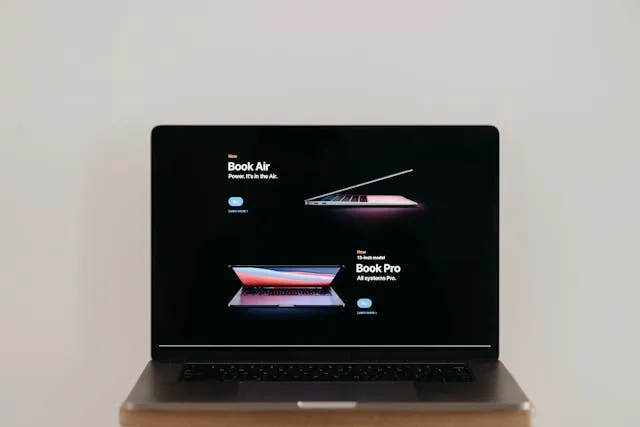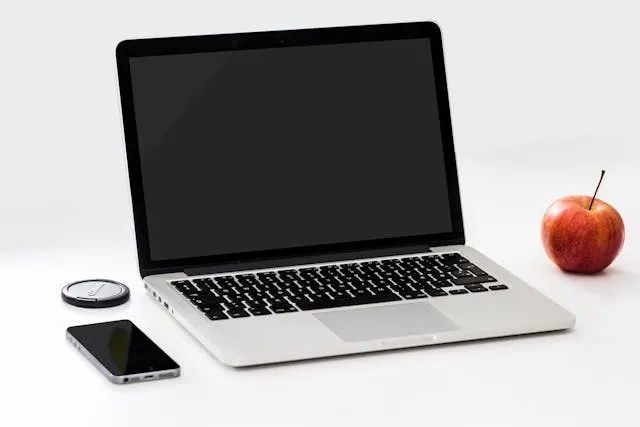Difference Between MacBook Air and Pro
When it comes to choosing a laptop, Apple’s MacBook lineup offers two popular options: the MacBook Air and the MacBook Pro. While both are powerful machines designed for different types of users, they have distinct differences that can influence your buying decision. In this blog post, we’ll delve into the key differences between the MacBook Air and MacBook Pro to help you make an informed choice.

Design and Portability
The MacBook Air is renowned for its slim and lightweight design, making it extremely portable and ideal for users who are always on the go. It features a tapered wedge shape, with its thickest point being just 0.63 inches (1.61 cm), making it easy to slip into a bag or backpack.
The MacBook Pro is slightly bulkier due to its more powerful components and cooling system. It has a uniform thickness, ranging from 0.61 inches (1.56 cm) to 0.64 inches (1.62 cm), depending on the model.
Display
One of the notable differences between the MacBook Air and MacBook Pro is their display technology. The MacBook Air typically comes with a 13.3-inch Retina display with a resolution of 2560 x 1600 pixels. It offers excellent color accuracy and brightness, making it suitable for everyday tasks, multimedia consumption, and light photo or video editing.
On the other hand, the MacBook Pro offers multiple display options, including a 13-inch and a 16-inch model. The Pro models feature a wider P3 color gamut, higher brightness levels, and True Tone technology for more accurate color reproduction, making them ideal for professional tasks such as graphic design, video editing, and content creation.
Performance and Configuration

In terms of performance, the MacBook Pro outperforms the MacBook Air, thanks to its more powerful processors and dedicated graphics options. The MacBook Air is typically equipped with Apple’s M1 chip, offering impressive performance and energy efficiency for everyday tasks and moderate multitasking.
In contrast, the MacBook Pro offers a range of processor options, including Intel Core i5 and i7 or Apple’s M1 Pro and M1 Max chips, along with dedicated graphics cards on certain models. This makes the MacBook Pro suitable for demanding tasks such as 3D rendering, software development, and heavy multitasking.
Connectivity and Ports
Another area where the MacBook Air and MacBook Pro differ is their connectivity options. The MacBook Air is known for its minimalist approach, featuring two Thunderbolt 3 (USB-C) ports and a headphone jack. While this is sufficient for many users, those who require more connectivity options may find it limiting.
On the other hand, the MacBook Pro offers a more extensive array of ports, including Thunderbolt 4 (USB-C) ports, an HDMI port, an SDXC card slot (on certain models), and a MagSafe charging port (on some models). This makes the MacBook Pro better suited for users who need to connect multiple peripherals and accessories simultaneously.
Battery Life
When it comes to battery life, the MacBook Air has the upper hand due to its energy-efficient design and lower power consumption. It can provide up to 15 hours of web browsing or up to 18 hours of video playback on a single charge, making it a reliable companion for long work sessions or travel.
The MacBook Pro, while still offering respectable battery life, tends to have slightly shorter endurance due to its more powerful components and higher energy consumption.

Pricing
Price is also a significant factor to consider when choosing between the MacBook Air and MacBook Pro. The MacBook Air is generally more affordable, starting at a lower price point compared to the MacBook Pro. However, as you configure the MacBook Pro with higher specifications such as faster processors, more storage, and dedicated graphics, the price can significantly increase, making it a more substantial investment.
Conclusion
In conclusion, both the MacBook Air and MacBook Pro are excellent laptops with distinct strengths and target audiences. The MacBook Air is perfect for users prioritizing portability, everyday computing tasks, and light content creation, while the MacBook Pro is geared towards professionals and power users who require top-notch performance, advanced display technology, and versatile connectivity options. Ultimately, your choice between the two will depend on your specific needs, budget, and preferences.
Whether you opt for the sleek and lightweight MacBook Air or the powerful and feature-rich MacBook Pro, you can rest assured that you’re getting a premium computing experience with Apple’s renowned build quality, reliability, and ecosystem integration.
Suggested Reading:
iPhone Security Lockout Fix: Tips and Solutions
What Is a Good Processor Speed for a Laptop?
How to Factory Reset Windows 11 without Settings
How to Hide Apps on iPhone 13 | A Guide on Unlocking Privacy
How to FaceTime on Android to iPhone | Bridging the Gap
How to Enable Secure boot Windows 11 | Safeguarding Your System
Two-Step Verification: What It Is and Why You Should Use It?
How to Pair Apple Watch to New Phone?
How to open BIOS Windows 11 | A Step-by-Step Guide
How To Remotely Logoff disconnected Users via Command Line?
MacBook Air Used | A Guide to Buying a Used MacBook Air
How to Change Name on iPhone Bluetooth: A Step-by-Step Guide

